Different Cuts of Beef and Prices
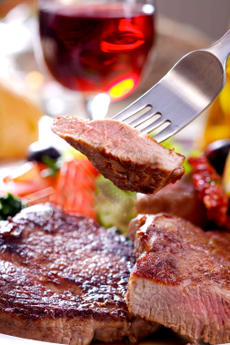 You don't need to buy a "top cut" to have a great steak experience. Read the wisdom of two top butchers.
You don't need to buy a "top cut" to have a great steak experience. Read the wisdom of two top butchers.
| MARIO FIORUCCI and TARA LONGO own and operate Toronto's Healthy Butcher on Queen Street West, where they are reviving the art of properly aged and butchered meat. Find out more at TheHealthyButcher.com. |
June 2007
Product Reviews / Main Nibbles / Meat & Poultry
Best Value Steak Cuts
The World's First Steak Guide To "Sustainable Steaks" Excludes Tenderloins, Strip Steaks & Rib Steaks
CAPSULE REPORT: We are automatically programmed to think of tenderloins, strip steaks and rib steaks as "the best." But are they? Two master butchers from the gourmet butcher shop, The Healthy Butcher, explain why you get more bang-for-the-buck with other delicious cuts.
- Overview
- Rating System
- The Winning Steaks
- What We've Learned From The Rankings
A steak guide without the coveted New York strip steaks, rib steaks, and filet mignon? Ludicrous? Well, not from our standpoint—"our" meaning any self-respecting butcher shop that has the availability, nay, we say pleasure, of buying whole animals, not just boxed muscles. Let's clear the air right off the top: We have excluded the three most expensive steaks, the bread and butter for most butcher shops, from our list for the following reasons:
- To celebrate the meat. Since industrialization in the meat industry kicked in—roughly fifty or so years ago—and the mass production of cheap boxed meat became commonplace, omnivores have become creatures of habit. To see these same three cuts on every restaurant and steak house menu, and to see these steaks take up the majority of display space in virtually every grocery store and butcher shop is, frankly, appalling and boring. We hate to break the news to anyone who thinks otherwise: A cow is not a walking loin. We owe it to our local farmers, the farmers who have a passion for what they do and how they do it, to explore their products in their entirety. Appreciation and exploration of whole animals is the sustainable way to eat meat.
- Less-marbled cuts are more flavorful. Although a certified organic, locally raised, well-marbled, and dry-aged New York Strip† or Rib Eye steak is pretty much a piece of heaven (we're not going to say otherwise), there is lot to be said about the flavor in tougher cuts of meat that is not present in the more tender cuts. Many argue that fat content is the sole factor in the determination of flavor, but chefs and food scientists have known for decades that there is an inverse relationship between flavor and tenderness, i.e. tougher cuts, regardless of fat content, are more flavorful. To this day, it is still a mystery, scientifically speaking, as to why tougher cuts tend to have more flavor. Our theory is that the increased flow of blood to a well-used muscle develops its meaty taste (or beefiness, in the case of beef). In any case, tougher cuts benefit from a fullness of flavor that is simply not present in the more tender cuts.
†NOTE: The same cuts of meat are often known by different names—none more so than the popular Boneless Strip, Kansas City Strip, New York, New York Strip, Shell Steak or Top Loin. If it gets confusing, see our Beef Glossary. - Better value. The value, meaning bang-for-your-buck, is higher for any steak on our list than for a Strip Steak, Rib Steak or Tenderloin. In fact, we could have just as easily named our list a "Value Steak Guide." We thought the term "sustainable" more accurately links your buying decisions to the farmers' reality.
| The best way to treat our list of steaks is to print a copy, stick it to your fridge and systematically, over the course of the summer, try each cut. You may very well rank the steaks differently; truth be told, and despite our repeated recommendations, number 9 and 10 on our list consistently out-sell number 1. Listen to the experts: The Boneless Blade Steak at the right ranked number one in flavor and price/value. Pick one up the next time you go shopping for steak. | 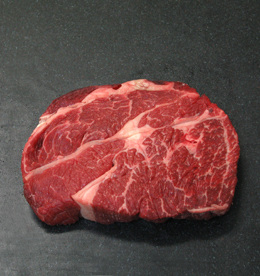 |
How We Rated The Steaks
We used four factors to come up with our Top 10 list: flavor, tenderness, price and personal opinion. If Einstein taught us anything, it's that we needed some markers for the objective categories, to which all cuts are judged relative. So this is what we came up with:
- Flavor: Rated from 0 to 10, with 0 being the least flavorful cut of beef (which we deemed to be the Eye of Round) and 10 being the most flavorful cut of beef (which we deemed to be the Beef Shank). There are several cuts we could have chosen to be the least and most flavorful; the point is, the least flavorful is one that is very low in fat, not on the bone and is a muscle that does little work. Conversely, the most flavorful cut is one that has ample fat content, benefits from being on the bone (especially marrow bones) and benefits from being a muscle that is used often.
- Tenderness: Rated from 0 to 10, with 0 being the toughest cut of beef (which we chose to be the Beef Shank, assuming it was cooked with dry heat like the other steaks it is being compared to) and 10 being the most tender cut of beef, the Tenderloin.
- Price: Ahh. For price, we had to kick up our creativity a notch. The percentages shown in the price columns below are the percentage savings from a either New York Strip or Rib Eye steak, calculated by the following formula:
| (Price of NY Strip or Rib Eye per lb) minus (Price of Cut We Are Comparing per lb) (Price of NY Strip or Rib Eye per lb) |
| So, for example, there is a 57% savings over a New York Strip Steak by purchasing a boneless blade steak. The percentage was then divided by 10 to yield a number between 0 and 10, to be consistent with the 10-point scale for the other categories. Just like rating a wine, you need to know the price prior to rating it: Ultimately is it worth the price, or more accurately, is it high in value? But, unlike wine—that ranges in price from less than $5 to more than $5,000 per bottle—it wouldn't be obvious to a reader of the list, relatively speaking, if we just plopped in $1.80/ounce in one line, and $2.75/ounce in another line. The differences seem almost negligible. We decided to measure value as the percentage savings over the pinnacles of steaks—the New York Strip Steak and the Rib Eye. In our store we price these two steaks equivalently. We're not quite sure why these steaks are differently priced in grocery stores. To us they're worth the same: Give up a little tenderness for the sake of more flavor in a rib steak, or give up a little flavor for the sake of more tenderness in a New York Strip Steak. |
- Personal Rating: For the only subjective category, our Head Butcher Ryan Donovan and our Head Chef Jonathan Abrahams, were each asked to rate the cuts from 0 to 5 on purely a personal preference. The two values added together yield a 0 to 10 point rating consistent with the other categories.
The Winners
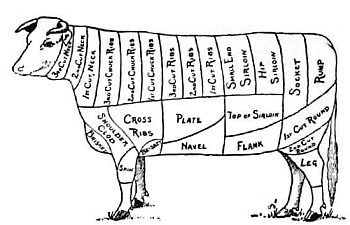 |
| 1st Place ~ BONELESS BLADE STEAK | |
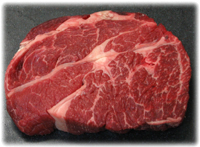 Boneless Blade Steak | The Blade is truly an overlooked gem. It is located in the chuck (or shoulder), which is the primary weight-bearing muscle group. More specifically, it is located in the Bottom Blade section; we point this out simply to differentiate it from the Flat Iron steak (another steak in this list) that is cut from the Top Blade section in the chuck, and is a little less tender. As a rule, meat from the chuck primal, although always flavorful, is usually tough and best for braising or stewing. The Blade is an exception to the rule and is surprisingly quite tender; in fact, the Boneless Blade Steak is cut from the exact same muscle as the premium Rib Eye steak that is more than twice the price. The only "catch" to this phenomenal steak is that there's a seam of cartilage running through the center; but for a 57% savings off a New York, we'll gladly take the extra step of slicing the cartilage out before serving. |
| Other Names | Book Steak, Butler Steak, Lifter Steak, Petite Steak, Paleron (French), Copertina di Spalla (Italian), Paletilla, Planchuela, or Parte Superior de la Paleta (Spanish). |
| Average Size* | Average Blade Steaks are .75lb (340g), but any size thickness can be cut on request. |
| Cooking Method | Braised blade is absolutely to die for, but superb results can be achieved on a grill by seasoning, searing over high heat, then lowering the heat slightly until the steak is cooked medium-rare. Tent with foil and let sit for 5 minutes before carving. Don't forget to cut along the center cartilage and remove it before serving. |
| Score |  |
| 2nd Place ~ THIN FLANK STEAK or VACIO | |
 Thin Flank Steak | The Thin Flank is situated in the Flank primal, but it is a very different cut from the "Flank" that everyone knows (just look at the photos of the two cuts—the Flank Steak is below—to see the obvious differences). Essentially, it's the cow's tummy muscle. |
| Other Names | Vacio (Argentina), Bavette (France), Costine di Pancia (Italy). |
| Average Size* | One Thin Flank is roughly 2.75lbs (1.2kg), but it can be cut and sold in smaller pieces. |
| Cooking Method | In Argentina, a Vacio would be thrown on a grill once the wood has burned down and left to cook for a long time: South Americans are champion slow grillers! Our dry-aged Thin Flank/Vacio can be grilled simply by seasoning, searing, then slow grilling over medium heat to a medium-rare. Let it sit for at least 5 minutes, then slice it thin and across the grain. Because of its large size, this is a terrific party steak; you can feed a lot of people with just one. |
| Score |  |
| 3rd Place ~ TRI TIP STEAK or ROAST | |
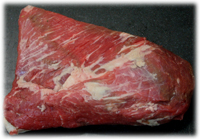 Tri Tip Steak | The Tri Tip comes from the bottom section of the sirloin (versus the #8 choicer below, Top Sirloin, which comes from the top section of the sirloin). This is a popular cut in the west (especially California) and many meat packers still ship their Tri Tip there, making it less frequently found in the Eastern parts of the U.S. or in Canada. (Don't forget, most butchers and grocers deal strictly with pre-cut "boxed" meat, so their choice of cuts may be limited, depending on the distributor.) |
| Other Names | Triangle Steak or Roast, Punta en Triangulo (Spanish). |
| Average Size* | 1.75lbs (790g). |
| Cooking Method | If the Tri Tip has been trimmed of all fat, ask to have another one cut for you, leaving the fat cap (in the photo above, the fat cap is on the bottom side and is not shown). Season, sear both sides, then cook on a lower heat with the fat side up until the center of the steak is medium rare. The Tri Tip is a perfect party steak because: (a) it's fairly large, and (b) the steak will vary in thickness from fairly thin to very thick, so by cooking the steak to a medium rare in the center, people who enjoy their meat more on the medium-well side can cut at one end, while the rare lovers can cut at the other end. The grain is fairly obvious in this muscle, so be sure to cut against the grain. Ask your butcher to show you the grain if it is not obvious to you. |
| Score |  |
| 4th Place ~ SKIRT STEAK | |
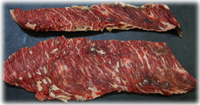 Skirt Steak | Skirt is one of the most flavorful of all steaks. It is situated in the short plate section of the beef, which is the inside of the rib on the chest. There are two types of skirt: Inside and Outside. It's a coin toss as to which is better; Inside Skirt is great because it doesn't have as much membrane to be removed, but Outside Skirt is a little thicker and a bit less stringy. Skirt is the meat originally used for both fajitas (which means "belt" in Spanish and reflects the shape of the skirt) and Philadelphia cheese steak sandwiches. |
| Other Names | Philadelphia Steak, Bavette Aloyau or Hampe (French), Falda, Entrana (Chile). |
| Average Size* | Outer Skirt 10.5oz (300g), Inner Skirt 16.7oz (475g). |
| Cooking Method | Season and cook quickly over high heat. Skirt has a very pronounced grain (just look at the photo). If cooked rare, sliced thin and against the grain, you will have as fine a piece of beef as you can find. |
| Score |  |
| 5th Place ~ BRISKET | |
| Brisket | The brisket is the front portion of the beef breast that lies between the front legs. Brisket is the cut of choice for Texas slow-smoked, pit-cooked barbeque. The only reason the brisket is not #1 on our list is (a) it's not really a steak, and (b) it takes a long long time to grill—we're talking on the order of 15 hours. When it comes down to it, a properly slow-smoked brisket is as good as it gets in the beef world. |
| Other Names | Poitrine Gros Bout (France), Petto (Italy), Pecho (Argentina). |
| Average Size* | A whole brisket, point and 1/2" fat cap left on, weighs between 10 to 12lbs (4.5 to 5.5kg). Of course, any smaller size can be cut. Allow about 1/2lb per person to allow for trimming and shrinkage. |
| Cooking Method | Brisket can be braised (like a pot roast), poached (as with corned beef), or hot-smoked (like southern-style barbeque, the reason this cut is on our list). There are more opinions and debates about how to properly smoke a brisket than any other cut. In our opinion, best results come from brining for 24 or more hours (the brine being a salt-based mixture that is best applied if injected into the brisket with a sryinge), dry rubbing with a mixture of spices, then slow grilling for 10 to 15 hours at around 180° to 200°F. The brisket is ready when it is falling apart, or "fork tender." |
| Score |  |
| 6th Place ~ FLAT IRON STEAK | |
 Flat Iron Steak | The Flat Iron sits in the Top Blade section of the chuck, on the other side of the shoulder blade from where our #1 pick, Boneless Blade Steak, is located (in the Bottom Blade). As compared to the Boneless Blade Steak, the Flat Iron is also very flavorful, slightly tougher, has no cartilage running through it and is a little more expensive. |
| Other Names | Flat Iron is often confused with the Boneless Blade Steak above, even though they are two distinct steaks. |
| Average Size* | .5 to .7lbs (220g to 320g), a perfect size for one steak per person. |
| Cooking Method | Same as Boneless Blade Steak. Flat Irons are usually thinner than Blades, so less cooking time is required: The steak will likely be finished after a good sear. Slice across the grain and serve. |
| Score |  |
| 7th Place ~ FLANK STEAK | |
 | The Flank Steak is easily distinguished by its longitudinal grain (see photo). Marinade can penetrate Flank Steak without the meat losing its firm texture because it is relatively thin and porous. Flank has a moderate amount of fat, a great beefy flavor, and no connective tissue. |
| Other Names | London Broil, Bavette Flanchet (France), Pancia or Bavetta (Italy), Bife de Vacio (Argentina), Bife do Vazio (Brazil), Palanca (Chile), Dunne (Germany). |
| Average Size* | 1.75lb (790g). One large Flank will serve about four people. |
| Cooking Method | Similar to the Thin Flank Steak or Vacio, season, sear, then cook at medium or medium-high heat until medium-rare. Tent with foil and let sit for 5-to-10 minutes, then slice thin across the grain. |
| Score |  |
| 8th Place ~ TOP SIRLOIN STEAK | |
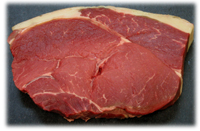 Top Sirloin Steak | The Top Sirloin comes from the Sirloin section of the beef, which falls between the lean and tough Round and the luxuriously tender Loin primals. Don't be fooled by the 8th place ranking: The Top Sirloin is a wonderful steak. The only reason it isn't at the top of our list is because its higher price pushed it down. That being said, at a 26% savings from the New York, this is a magnificent steak, both tender and flavorful. |
| Other Names | Coulotte, Bifteck (French), Bife (Argentina), Bistek (Chile). American retail butchers often call this steak Chateaubriand, but we feel that French name should be reserved for the large butt end section of the Tenderloin. |
| Average Size* | From 1lb to 1.75lb (454g to 790g), depending on whether it is cut from the loin side or the round side. Generally, one Top Sirloin can feed 2 to 3 people. |
| Cooking Method | Season, sear and cook at medium-high heat until medium rare. Also note that a Top Sirloin Roast makes for a great barbecue roast. |
| Score |  |
| 9th Place ~ SIRLOIN TIP | |
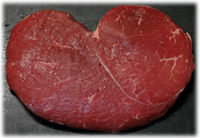 Sirloin Tip | The Sirloin Tip is the continuation of the sirloin muscle that is the source of Top Sirloin steaks (see #8 above). However, because the tip is situated in the Round primal, it is tougher and leaner. As far as extra-lean steaks go, this is the best it gets. |
| Other Names | Knuckle Steak, Breakfast Steak, Tranche Grasse (France), Rabadilha (Portugal), Bola de Lomo (Argentina), Patinho (Brazil), Posta Rosada (Chile). |
| Average Size* | 1lb (450g) per steak. |
| Cooking Method | Season, sear and cook to medium-rare over medium-high heat. Do not overcook! |
| Score |  |
| 10th Place ~ EYE OF ROUND | |
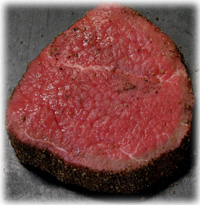 Eye of Round | Rounding out our Top 10 list is the Eye of Round. The Eye is the leanest muscle in beef, which probably explains its popularity among our health-conscious customers. It comes from the Round Primal, and because it is a well-used muscle, it is a bit chewy. If you're looking for a lean, small steak that is unbelievably economical, this is a good choice. |
| Other Names | Tranche or Piece Ronde or Roti de Boeuf (French), Girello or Magatello (Italian), Peceto (Argentina). |
| Average Size* | Average .5lb (220g) per steak, but it can be cut thinner or thicker to preference. Shown in the diagram is a 3-peppercorn-encrusted Eye. |
| Cooking Method | Since the Eye of Round has so little fat, it is best not to cook it past rare or medium-rare. Season, sear and cook to medium-rare over medium-high heat. |
| Score |  |
*Average size for The Healthy Butcher; average sizes may vary regionally.
What We Learned From The Rankings
This was an exercise for us as well as for you. Here's what we learned.
- Price was obviously a significant factor that tipped the scales (no pun intended). The least expensive steak, the Boneless Blade Steak, took the top rank. And the most expensive steak on the list, the Top Sirloin, placed only eighth. Using the wine analogy again, it became obvious that for a $10 bottle, the Blade was as good as it gets, but more was expected from the Top Sirloin, being a $20 bottle.
- The rankings also show the importance of fat. Is it a surprise that the three leanest cuts in our Top 10 are numbers eight, nine, and ten? Fat plays multiple roles in meat. First, it improves tenderness by acting as a lubricant between meat fibers, making the fibers easier to pull apart. Second, fat carries flavor compounds. In fact, if all fat were removed from meat, it would be difficult to differentiate between several types of red meat because they would taste so similar. And third, fat stimulates the flow of saliva, which has the effect of further stimulating taste.
- Most important to understand with our Top 10 list is that all of these steaks are sustainable steaks. These cuts represent a whole animal, excluding the oversold and premium-priced loin and rib sections. No matter which cut you choose from the above list, you can feel comfortable that not only are you being frugal, you are supporting sustainable farming. The results of sustainable eating trickle down to everything from helping the farmers' livelihood to improving local groundwater. Eat well, do well.
© Copyright The Healthy Butcher. All rights reserved. All other material Lifestyle Direct, Inc. Images are the copyright of their respective owners.
![]()
© Copyright 2005-2022 Lifestyle Direct, Inc. All rights reserved. All images are copyrighted to their respective owners.
Source: https://www.thenibble.com/reviews/main/meats/beef/best-value-steak-cuts.asp

0 Response to "Different Cuts of Beef and Prices"
Postar um comentário